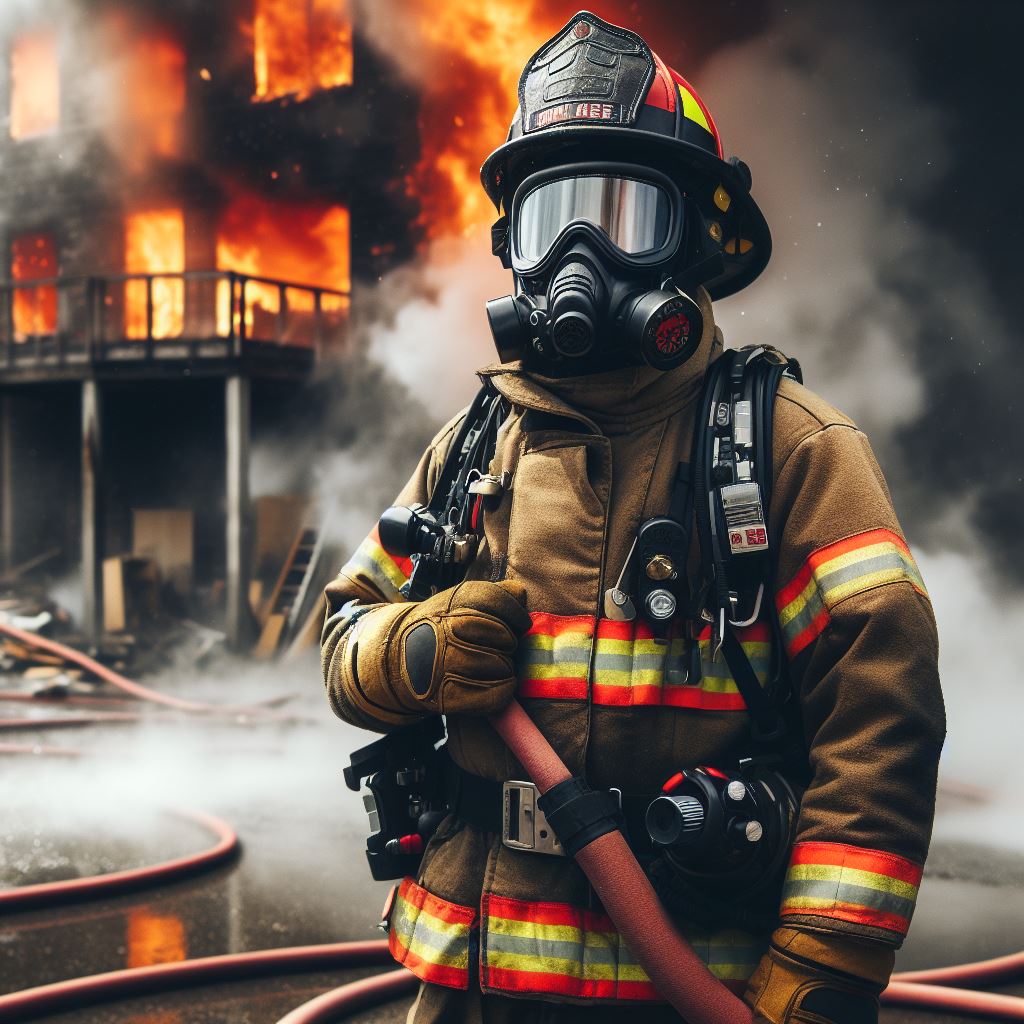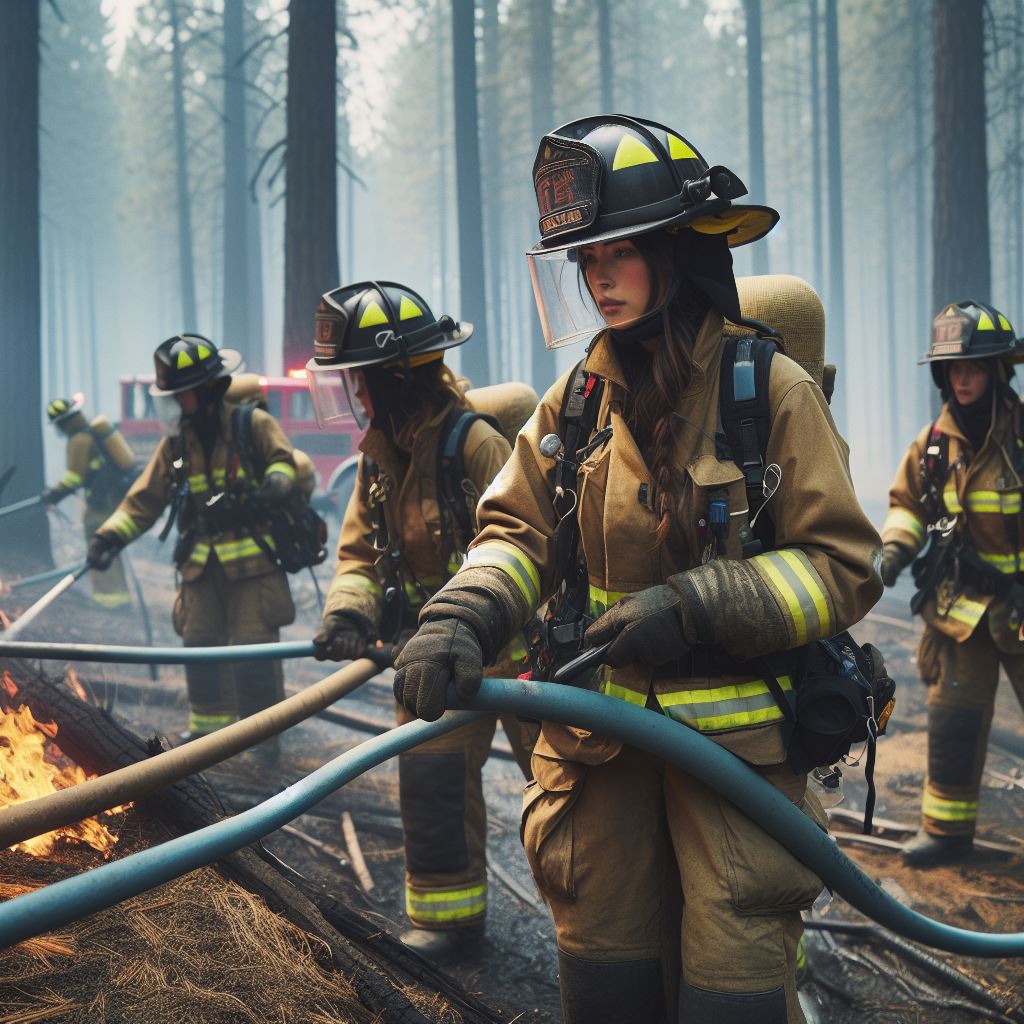Introduction
Firefighting in 2024 promises groundbreaking innovations.
Drones equipped with thermal imaging enhance situational awareness for firefighters on the ground.
These drones swiftly navigate through smoke, providing real-time data crucial for strategic decision-making.
Advanced firefighting suits integrate smart sensors to monitor vital signs, ensuring the well-being of firefighters amidst intense heat.
Augmented Reality (AR) helmets offer enhanced navigation and communication capabilities, reducing response time in critical situations.
Robotics takes center stage with agile, fire-resistant robots capable of entering hazardous areas.
These robots assist in extinguishing flames and rescuing victims, minimizing human exposure to danger.
Furthermore, AI-driven predictive analytics enable proactive firefighting strategies by forecasting potential fire outbreaks based on environmental conditions.
In 2024, these technological leaps empower firefighters, revolutionizing their approach and resilience in combating blazes.
The future of firefighting is now, with cutting-edge tech paving the way for safer, more effective emergency responses.
Overview of Firefighting Challenges in 2024
Discussing the evolving nature of fires and the challenges faced by firefighters
In 2024, firefighting challenges have become increasingly complex due to the evolving nature of fires.
Traditional firefighting techniques are no longer sufficient to combat the modern fire threats that firefighters encounter on a daily basis.
The first challenge faced by firefighters in 2024 is the increased frequency and intensity of wildfires.
Climate change has resulted in drier and hotter conditions, creating the perfect environment for wildfires to spread rapidly.
These fires can quickly become unmanageable, posing a threat to both lives and property.
Another major challenge is the rise in urban fires. As cities continue to grow, the risk of fires in densely populated areas increases.
Urban fires often have unique characteristics, such as the presence of high-rise buildings and complex infrastructures.
Firefighters must navigate through narrow streets and deal with limited access, making it more difficult to control and extinguish these fires.
Additionally, the use of hazardous materials in industries and households has also presented new challenges for firefighters.
Chemical fires and explosions can be extremely dangerous and require specialized knowledge and equipment to handle safely.
Firefighters must continuously update their skills to stay ahead of these emerging threats.
Highlighting the need for advanced technologies to combat modern fire threats
To address these evolving challenges, there is an urgent need for advanced technologies in firefighting.
Traditional firefighting tools, such as hoses and extinguishers, are no longer enough to effectively extinguish modern fires.
Firefighters require innovative solutions that can match the pace and complexity of these threats.
One such technology is the development of advanced fire suppression systems.
Unlock Your Career Potential
Visualize a clear path to success with our tailored Career Consulting service. Personalized insights in just 1-3 days.
Get StartedThese systems utilize cutting-edge materials and design principles to quickly and efficiently extinguish fires.
For instance, new types of fire-retardant foams can provide better coverage and longer-lasting protection against fires.
Another important technological advancement is the use of unmanned aerial vehicles (UAVs) in firefighting operations.
UAVs equipped with thermal imaging cameras allow firefighters to assess the situation from a safe distance and identify hotspots.
They can also carry firefighting agents or drop water or fire retardants on inaccessible areas, significantly enhancing firefighting capabilities.
The role of technology in increasing firefighter safety and efficiency
In addition to combating fires, advanced technologies play a crucial role in enhancing firefighter safety and efficiency.
Firefighters often put their lives at risk to save others, and technology can help minimize these risks.
For example, wearable technologies such as heat-resistant suits and breathing apparatus provide firefighters with increased protection and comfort in extreme conditions.
These suits are designed using advanced materials that can withstand high temperatures and provide better insulation.
Furthermore, communication and information technologies have greatly improved the coordination and efficiency of firefighting operations.
Real-time data sharing and integrated command systems enable better situational awareness and decision-making.
Firefighters can now access critical information about the fire’s behavior, location, and hazards, allowing them to respond more effectively.
In fact, firefighting challenges in 2024 are becoming more complex due to the evolving nature of fires.
To combat these threats, advanced technologies are essential.
These technologies not only help extinguish fires but also enhance firefighter safety and efficiency.
As the landscape of firefighting continues to change, it is crucial for fire departments to embrace these advancements and equip their personnel with the necessary tools for the future.
Read: Firefighters’ Role in Canadian Communities
Importance of Technological Advancements in Firefighting
Discussing how technology has historically transformed firefighting methods
- Firefighting has come a long way from relying solely on manual techniques.
- In the past, firefighters used buckets, axes, and hoses to combat fires.
- Technological advancements have revolutionized firefighting practices over the years.
- With the invention of the fire engine, firefighters gained mobility and improved water supply.
- Additionally, the development of fire hydrants facilitated efficient water distribution during firefighting operations.
- Moreover, the introduction of self-contained breathing apparatus (SCBA) enhanced firefighter safety during rescue operations.
- Historically, technology has played a crucial role in increasing the effectiveness and efficiency of firefighting efforts.
Highlighting the benefits of technological advancements in the field
- Modern firefighting equipment allows firefighters to tackle complex situations with greater ease.
- Advanced thermal imaging cameras aid in identifying hidden fire sources and locating trapped victims.
- Improved communication systems enable seamless coordination among the firefighting team.
- Enhanced firefighting robots can access hazardous areas, minimizing human risk.
- High-pressure water mist systems effectively suppress fires and reduce property damage.
- Incorporation of drones in firefighting operations allows for aerial surveillance and situational assessment.
- Technology has significantly reduced response times and improved overall safety during fire emergencies.
The need to stay updated with the latest firefighting technologies
- As technology continues to evolve, it is crucial for firefighters to adapt and learn new techniques.
- Regular training is necessary to ensure proficiency in handling advanced firefighting equipment.
- Being aware of the latest technological advancements enables firefighters to make informed decisions.
- Constant innovation equips firefighters with effective tools to combat ever-changing fire hazards.
- Staying updated with advancements fosters continuous improvement in firefighting strategies.
- Training programs that focus on technological advancements can enhance operational efficiency.
- It is imperative for fire departments to invest in updating their equipment and adopting new technologies.
Technological advancements have revolutionized firefighting, ensuring greater safety for firefighters and improved outcomes during emergencies.
As history has shown, innovation in firefighting techniques has been instrumental in saving lives and minimizing property damage.
From the evolution of firefighting tools to the introduction of cutting-edge equipment, technology has played a pivotal role in transforming the field.
The benefits are numerous, including increased mobility, enhanced communication, improved safety measures, and more effective firefighting methods.
It is crucial for firefighters to stay updated with the latest technologies and undergo regular training to remain skilled and competent in their roles.
By embracing technological advancements, fire departments ensure they are equipped with the most efficient tools to handle emergencies and protect their communities.
To serve and protect, staying on the forefront of technology is an indispensable aspect of modern firefighting.
Read: How to Become a Firefighter in Canada
Notable Firefighting Tech Advancements in 2024
AI-Powered Drones for Fire Surveillance
AI-powered drones have become indispensable tools in firefighting operations due to their ability to enhance fire surveillance capabilities.
Equipped with advanced sensing technologies and artificial intelligence algorithms, these drones can efficiently monitor and assess fire situations from the air.
These drones are equipped with thermal cameras and smoke detectors, allowing them to detect even small fires or hotspots that might not be immediately visible to the naked eye.
By flying over the affected areas, they capture high-resolution images and videos, creating detailed heat maps that help firefighters identify the fire’s intensity and spread.
One of the significant advantages of AI drones is their ability to provide real-time critical data to firefighters on the ground.
Using wireless communication systems, these drones transmit information on fire behavior, temperature gradients, and potential hazards to the command center or directly to handheld devices of firefighters.
This enables real-time decision-making and enhances the overall effectiveness of firefighting efforts.
Furthermore, AI drones are also capable of autonomously navigating through smoke-filled environments, making them valuable assets in situations where visibility is severely compromised.
They can quickly identify hotspots and potential fire sources, guiding firefighters to the areas that require immediate attention.
This advanced surveillance capability significantly reduces the time needed to pinpoint the fire’s origin and facilitates more efficient deployment of resources.
Advanced Fire Extinguishing Agents and Sprinkler Systems
In 2024, a significant breakthrough in fire suppression technology has been the development of new fire extinguishing agents utilizing nanoparticles.
These tiny particles, often measuring less than 100 nanometers, have revolutionized the field of fire science and extinguishing technology.
Nanoparticles possess unique capabilities due to their high surface area-to-volume ratio, which enhances heat absorption and extinguishing efficiency.
When introduced into a fire-affected area, these nanoparticles can rapidly absorb heat, reducing the temperature and suppressing the flames.
Additionally, they create a protective layer on the surfaces, preventing reignition and reducing the risk of fire escalation.
The advantages of nanoparticles in fire suppression extend beyond their effective heat absorption.
Compared to traditional fire extinguishing agents, such as water or foam, nanoparticles require less volume to achieve the same level of suppression.
This leads to weight and space savings, particularly in portable firefighting equipment.
Moreover, the rapid cooling effect of nanoparticles minimizes thermal damage to the surroundings, reducing the overall collateral damage caused by fire suppression efforts.
Furthermore, advanced sprinkler systems incorporating the latest technological advancements have significantly improved their effectiveness in suppressing fires.
These systems can detect fires at an earlier stage and deliver an optimal amount of extinguishing agent precisely and efficiently.
The integration of AI algorithms allows the sprinkler systems to adapt in real-time to changing fire conditions, optimizing water usage and minimizing water damage to the property.
Augmented Reality (AR) Firefighting Simulation
Augmented Reality (AR) technology has found its way into firefighter training programs, transforming the way emergency response personnel acquire essential skills.
By leveraging AR simulations, firefighters can experience realistic scenarios that replicate the challenges and dangers they may encounter during actual wildfires or building fires.
AR firefighting simulations offer a highly immersive and interactive training environment.
Using specialized headsets or handheld devices, trainees can visualize themselves in various firefighting situations, ranging from navigating through burning buildings to extinguishing large-scale forest fires.
The simulations provide a safe space to practice critical decision-making, tactical maneuvers, and effective communication within a team.
The ability to train in realistic scenarios enhances firefighters’ decision-making skills under stress and improves their response times.
They gain valuable experience in assessing risks, identifying potential hazards, and choosing the most appropriate firefighting strategies.
By mastering these skills in a virtual setting, firefighters are better prepared to handle complex fire incidents and ensure the safety of themselves and the public.
Integrated Communication and Tracking Systems
Communication and coordination among firefighters are crucial elements for successful firefighting operations.
In recent years, significant advancements have been made in communication systems tailored specifically to the needs of firefighters, greatly improving their ability to communicate and coordinate during emergencies.
Modern communication systems integrate various technologies, such as voice communication, data transmission, and real-time video streaming.
Firefighters can communicate seamlessly with each other and command centers using wireless devices or integrated communication helmets.
This promotes efficient information exchange, facilitates situational awareness, and enables swift decision-making based on accurate and up-to-date information.
Another notable development is the introduction of real-time tracking systems for firefighting personnel.
These systems utilize wearable trackers or embedded sensors to monitor the location and movement of firefighters during firefighting operations.
Command centers can track the positions of all personnel in real-time, ensuring their safety and optimizing resource allocation.
In emergency situations, this tracking capability is essential for rapid response, quick identification of personnel in distress, and overall accountability.
The integration of advanced communication and tracking systems revolutionizes the way firefighters operate.
It enhances their effectiveness, minimizes response time, and maximizes the safety of both the firefighters and the public they serve.
By leveraging these technological advancements, firefighting agencies can mitigate fire incidents more efficiently and better protect lives and properties.
Read: Fitness Tips for Aspiring Firefighters

Impact of Technological Advancements on Firefighting
In the year 2024, the advancements in firefighting technology have brought about significant positive implications for firefighter safety and efficiency.
Discussing the positive implications of technology for firefighter safety and efficiency
- Improved Protective Gear: Technological advancements have led to the development of advanced firefighting gear that can withstand higher temperatures and provide enhanced protection.
- Enhanced Communication: Firefighters now have access to advanced communication systems, allowing them to coordinate and communicate more effectively during emergencies.
- Efficient Fire Suppression: New firefighting technologies, such as advanced fire retardants and extinguishing systems, have made fire suppression more efficient and effective.
- Enhanced Situational Awareness: Technologies like heat-sensing cameras and unmanned aerial vehicles help firefighters assess the situation better and make informed decisions.
- Improved Rescue Operations: Robotics and drones equipped with cameras and sensors assist in locating individuals and navigating hazardous areas, improving rescue operations.
Highlighting the potential reduction in casualties and property damages
- Early Detection and Response: Advancements in fire detection systems enable firefighters to detect fires at an early stage, reducing the risk of casualties and property damages.
- Remote Monitoring: Intelligent monitoring systems allow firefighters to monitor fire conditions remotely, enabling swift response to prevent escalation.
- Increased Efficiency in Evacuation: Advanced evacuation systems and communication technologies help evacuate occupants quickly and efficiently, minimizing casualties.
- Effective Fire Suppression: Technological innovations in firefighting equipment and techniques enable firefighters to suppress fires faster, minimizing property damages.
- Predictive Analytics: The use of data analytics helps identify potential fire risks and take proactive measures to prevent accidents, reducing casualties and property damages.
The importance of constant adaptation to emerging firefighting technologies
- Staying Ahead of Fire Risks: Constant adaptation to emerging technologies allows firefighters to stay one step ahead of evolving fire risks and combat them effectively.
- Enhancing Skillset: Regular training and upskilling in the latest firefighting technologies ensure that firefighters are proficient in operating advanced equipment.
- Increasing Effectiveness: By embracing emerging firefighting technologies, firefighters can enhance their effectiveness in saving lives and protecting property.
- Collaboration and Knowledge Sharing: Constant adaptation to emerging technologies encourages collaboration among firefighters and enhances knowledge sharing within the firefighting community.
- Ensuring Future Readiness: Embracing emerging technologies prepares firefighters for future firefighting challenges and enables them to respond effectively to evolving scenarios.
In short, the impact of technological advancements on firefighting in 2024 has been substantial.
These advancements have improved firefighter safety and efficiency, reduced casualties and property damages, and emphasized the importance of constant adaptation to emerging technologies.
By embracing these advancements, firefighters can better protect lives and property in the face of fire emergencies.
Read: Top Firefighting Schools Across Canada
Explore Further: Firefighting: Full-Time vs. Part-Time
Conclusion
Firefighting in 2024 has undergone a revolution with cutting-edge technologies leading the charge.
Drones equipped with thermal imaging provide real-time data, enhancing situational awareness for firefighters.
Augmented reality (AR) helmets offer critical information overlay, aiding navigation through smoke-filled environments.
Advanced fire-resistant materials and suits ensure enhanced protection for first responders.
The integration of artificial intelligence (AI) algorithms enables predictive firefighting, identifying potential hotspots before they escalate.
Water-efficient firefighting drones and robots streamline extinguishing processes, minimizing water wastage.
Smart sensors within buildings detect fire outbreaks at their inception, triggering rapid response mechanisms.
Furthermore, the adoption of 5G technology facilitates seamless communication among firefighting teams, optimizing coordination during emergencies.
These groundbreaking advancements underscore the critical need for the firefighting industry to embrace and incorporate these technologies, ushering in a new era of efficiency and safety.
The future of firefighting is undoubtedly bright, with these innovations paving the way for a safer and more effective approach to combating fires.




